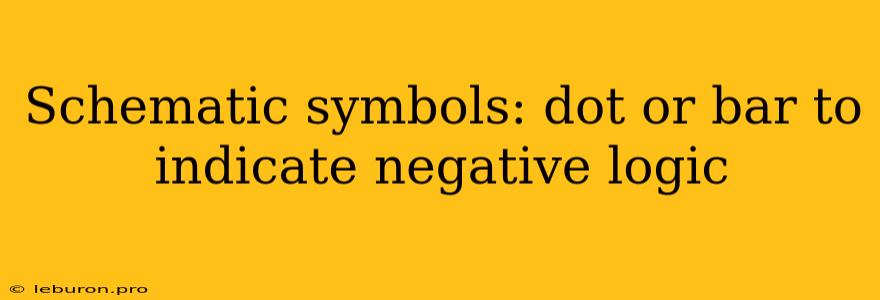In the world of digital electronics, understanding the nuances of logic gates and their representation is paramount. Schematic symbols, the visual language of circuits, play a crucial role in conveying information about how components interact. One aspect that often causes confusion for beginners is the use of dots or bars within symbols to indicate negative logic. This article delves into the concept of negative logic, its representation using dots or bars, and how to interpret these symbols effectively.
Understanding Negative Logic
Negative logic, in contrast to positive logic, defines a high logic level (1) as a low voltage and a low logic level (0) as a high voltage. It's important to note that the voltage levels themselves remain the same, but the interpretation of those levels is reversed. This concept may seem counterintuitive at first, but it finds its application in certain digital circuits and is particularly useful for simplifying circuit design in some cases.
The Role of Dots and Bars
Dots and bars are visual cues used within schematic symbols to denote negative logic. These indicators are typically added to the standard logic gate symbols, signifying that the input or output being referenced uses the opposite logic convention. Here's a breakdown of how dots and bars are used:
Dots for Negated Inputs
A dot placed on a logic gate input indicates that the input is actively low. This means that a low voltage (0) at that input will produce a high output (1), and vice versa.
For example, consider a NAND gate symbol with a dot on one of its inputs. A low voltage at the dotted input will result in a high output, just as a high voltage at both non-dotted inputs would. Essentially, the dot acts as a logical inverter for that specific input.
Bars for Negated Outputs
A bar placed over the output of a logic gate indicates that the output is negated, meaning a high output (1) from the gate will be represented as a low voltage (0) and vice versa.
For instance, a NOT gate with a bar over its output symbol signifies that a high input (1) produces a low output (0).
Interpreting Symbols with Dots and Bars
When encountering schematic symbols with dots or bars, follow these steps for accurate interpretation:
- Identify the gate type: Determine the type of logic gate (AND, OR, NAND, NOR, XOR, etc.) being represented.
- Recognize the presence of dots or bars: Note the presence of dots on inputs or bars over outputs.
- Apply negative logic rules: For dotted inputs, a low voltage (0) corresponds to a high logic level (1), while for barred outputs, a high output (1) from the gate is represented as a low voltage (0).
Example: A NAND Gate with a Dotted Input
Let's examine the example of a NAND gate with a dot on one of its inputs. This symbol indicates that the input with the dot uses negative logic.
- Input A: If input A is high (1), it behaves as a normal NAND gate.
- Input B: If input B is low (0), it acts as a high logic level (1).
- Output: The output will be high (1) only when both inputs A and B are low (0).
In essence, the NAND gate with a dotted input acts like a NOR gate with its inputs reversed. This emphasizes the fact that negative logic simply alters the interpretation of voltage levels, not the underlying logic function of the gate.
Advantages and Disadvantages of Negative Logic
While it might initially appear complex, negative logic offers certain advantages:
- Circuit Simplification: In some scenarios, using negative logic can simplify the design and implementation of digital circuits. This can lead to fewer gates required, reducing complexity and cost.
- Improved Noise Immunity: Negative logic can offer better noise immunity in certain situations, as it reduces the susceptibility of logic levels to unwanted voltage fluctuations.
However, there are also disadvantages to consider:
- Complexity: Negative logic can be challenging to grasp for beginners, and its use can complicate circuit analysis.
- Compatibility: It can lead to incompatibility issues when integrating with circuits using positive logic.
Conclusion
Understanding negative logic and its representation using dots and bars is crucial for accurately interpreting schematic diagrams. By applying the rules associated with dots and bars, you can decipher the behavior of logic gates and analyze the functionality of digital circuits employing negative logic. While it may seem intricate at first, grasping this concept opens up new possibilities for circuit design and analysis.
